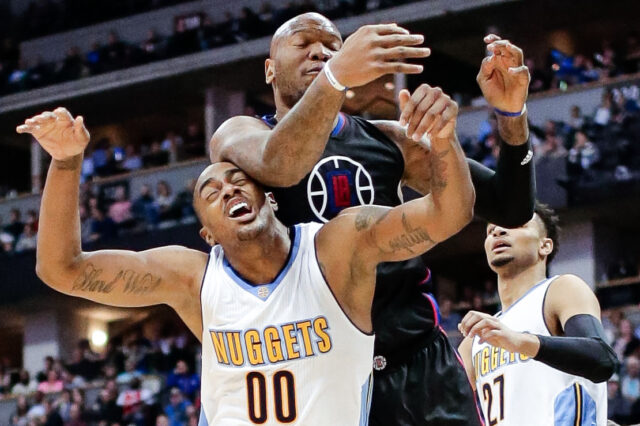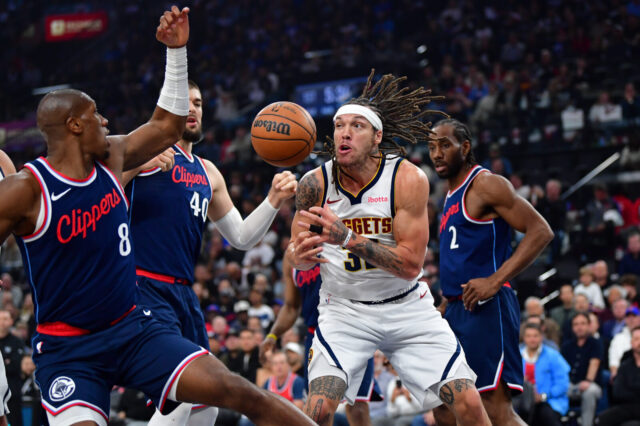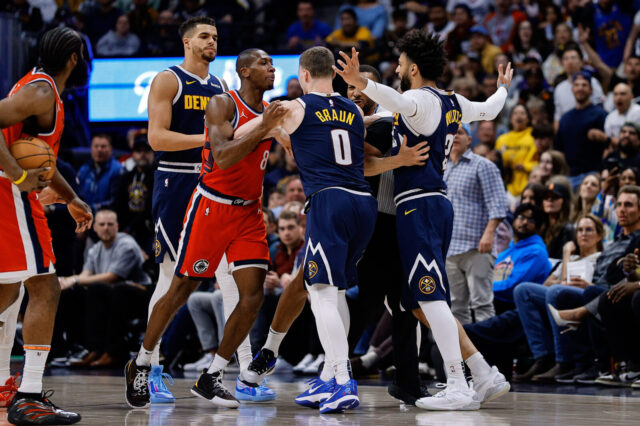Anthony Irwin of Silver Screen and Roll came on the Pickaxe Podcast with Denver Stiffs' own Adam Mares to talk about the pair of Lakers games, and the Lakers blogger and former shooting coach voiced the concerns of many when talking about Emmanuel Mudiay's offense:
"His shot is really worrisome to me… His athleticism is more than enough to make up for it. He's really long. I like his dribbling style for the most part… but he was wide open today – there was nobody with 7 feet of him, 10 feet of him even – and he went to rise up and as he was shooting I kind of chuckled.
I feel bad for the guy. The guy he reminds me of (but more explosive) is Rondo, where he's so long, and Rondo at his peak you didn't understand quite how athletic he was until he really decided, "all right, I'm gonna really get out on this transition and elevate" or whatever. Mudiay's a lot more explosive but [reminds me of] when I used to watch Rondo shoot, especially in the seven game series that the Lakers played where Phil basically put Kobe on Rondo and said, 'If you're anywhere within seven feet of Rondo you're working way too hard defensively.'
I watched Mudiay play and if I was coaching against him I would say, 'Look, the only way he's going to beat you is if he gets by you, if he gets into the key, if he's able to break down your defense and then kick it out to an actual shooter. And if you let him do that, that's not just a physical breakdown that's a mental breakdown.' …Unless he fixes that I don't know that he's going to be a night-in, night-out threat to any team."
Strong words, but ones that many Nuggets fans have voiced watching Mudiay put on one of the most appalling early shooting performance starts in any back court career.
As Adam said in the podcast, Mudiay put in a lot of work last year to improve that but fixing his shooting is going to be a multi-year process. Last year Mudiay had the assistance of one of the great three-point shooters in NBA history, Mike Miller, and together they worked to fix some of the most egregious elements in his jump shot. It certainly seemed to help as the season went on:
Mudiay, pre-All-Star: 27.2% from 3, 36.0% from 2, 61.6% FT
Mudiay, post-All-Star: 36.4% from 3, 40.4% from 2, 77.5% FT
For comparison, Ty Lawson shot 36.9% from 3 and 77.1% from the charity stripe as a Nugget. Lawson was a much better finisher with his two point shots (49.2%) but Mudiay doesn’t really have a good reason for finishing that poorly with his size and ability to get to the rim, so that should come up significantly as well. But is Mudiay’s post-All-Star statline his new floor, or just an aberration? His shot still looks awkward and may take several more years to iron out.
Which begs the question: with this many young kids on the roster and with shooting being such a huge key in the modern NBA, why are the Nuggets relying on players to coach each other on that aspect of their games?
Weirdly, the Nuggets are not alone in that. Several teams do not have an on-staff shooting coach, although as this excellent article from the Ringer points out, many are starting to adopt the process. But what do you do if you don’t have one?
"In the past I’ve asked coaches and players how they plan to improve a player’s jump shot, and the response is ‘more reps,’" Townsend says. "Maybe they just don’t want to go into detail, but oftentimes that is what teams really think is necessary. But that mind-set discounts the necessary mechanical changes a player may need to undergo."
Right now it looks like Denver is trying to get around this issue by drafting better shooters who don’t come with as many mechanical limitations. Jamal Murray and Malik Beasley were two of the best shooters in the draft, and even international big men Juancho Hernangomez and Petr Cornelie are better shooters than expected as front court players. All four can hit threes and none has the kind of shot issues that plague a Kenneth Faried or Emmanuel Mudiay.
But there won’t always be shooters available, and every shooter can get better at something. Whether it’s developing the Jordan fadeaway when the legs go or being better able to cash in the free throws that a bowling-ball style lane driver earns, a shooting coach would earn his money a hundred times over.
When a second contract for a key player is now going to run nine figures, the investment of a relative pittance in salary for an actual talent at that shooting coach position makes too much sense. Not every team has a shot doctor on staff yet, but in 10 years I’d be surprised if there are any holdouts.
As the Ringer article states: shooting is the new arms race in the NBA. Denver was 26th in the NBA in three point shooting last year, and 27th in three point percentage allowed. Malone wants to fix the latter first, but while he’s focused on that perhaps the Nuggets should help him fix the former with some added coaching.
Spacing doesn’t mean much if the open player can’t knock down a shot. And for an organization whose best regular season ended with the indelible image of a Corey-Brewer-bricked 3 sticking between the rim and the backboard, improving shooting should be a huge priority – by any means necessary.
This content is no longer available.
This content is no longer available.


